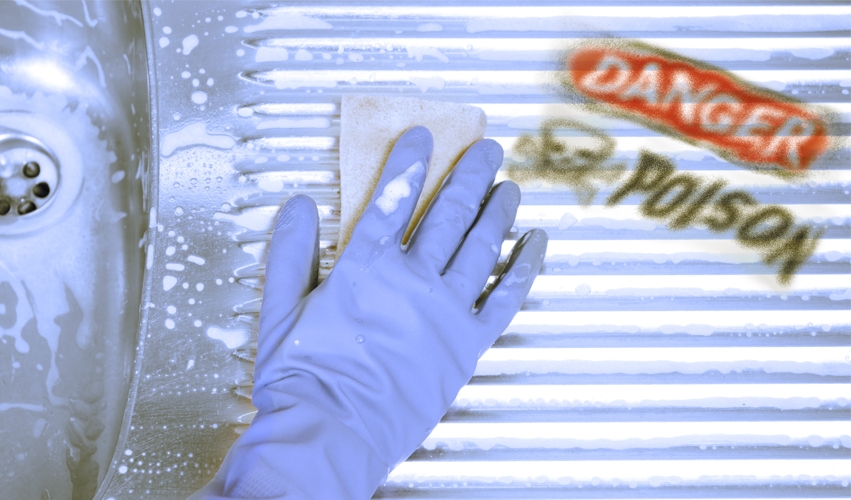After covering the safer acid cleaners, it’s now time to dive into the harsher and stronger acidic cleaners that are out there.
These cleaners are highly toxic and may be corrosive. Avoid getting them on your skin or in your eyes and avoid getting them on other materials since the acids may have bleaching effects, eat through metals, or etch surfaces and porcelain enamel. Always read the labels on these products and follow the directions to ensure your own safety.
Hydrochloric acid comes from a mixture of regular salt and sulfuric acid and when made into concentrated solutions, it is extremely corrosive. Diluted solutions are commonly found in household cleaning products, making them only mildly corrosive. It’s very important not to not let cleaners with hydrochloric acid come into contact with eyes and skin. In domestic uses, it’s used in toilet bowl cleaners to remove dirt and grime. For commercial use, it cleans mortar spills off new bricks, removes rust from metals and other surfaces and etches floors before sealing them. It will also eat through cotton, rayon, and mortar and is very corrosive to metals.
Hydrofluoric acid is a commercial rust remover that’s a solution of hydrogen fluoride in water, it’s colorless, acidic and highly corrosive. Used to make most fluorine-containing compounds with the most popular example being the commonly used pharmaceutical antidepressant medication known as Prozac and Teflon, the material used in cookware and kitchen utensils. Pro tip: do not use on glass windows or glass products.
While a bleaching agent, oxalic acid is an effective rust remover but is poisonous and corrosive. Keep children and pets away while using this product and throw away cloths and brushes used to apply it. If you don’t use this safety protocol, oxalic acid could be transferred to kitchen utensils and dishes, then accidentally ingested.
Sodium acid sulfate, can be found in toilet bowl cleaners. It’s a compound made by combining sodium, hydrogen, sulfur and oxygen ions – it is poisonous and should be used with extreme caution.
Sodium hypochlorite is a chemical used in bleaching solutions, disinfectants, water purifiers, and cleaning products. As a disinfectant, it attacks and destroys bacteria, viruses and mold. It can be found in toilet bowl cleaners, tile and grout cleaners and other products. If swallowed, it can lead to poisoning and breathing the fumes may also cause poisoning, especially if the product is mixed with ammonia.
Sulfuric acid is a strong drain cleaner and can be found in some toilet bowl cleaners. While an effective oxidizer, it attacks nylon, vinyl and most organic substances, burning skin and emitting dangerous fumes.
At Go Green, we’re not just a cleaning company. We’re your partners in creating a cleaner, healthier, and more sustainable environment for your business in Edmonton.
(780) 437-1011At Go Green, we’re not just a cleaning company. We’re your partners in creating a cleaner, healthier, and more sustainable environment for your business in Edmonton.

With over 40 years of combined experience in the field of facilities services, We offer our clients top quality cleaning and maintenance services with high standards, and we are committed to only using environmentally friendly cleaning products. Read more below to learn about touch point cleaning, and why keeping your spaces clean is important to your health.
Read More
Typical household cleaners are on the top of the list of dangers in our homes. They cause indoor air pollution, which means many of us will suffer from skin, respiratory and eye irritation. Even if you leave your windows open and turn your bathroom fan on, you are still inhaling and exposing yourself to these chemicals.
Read More